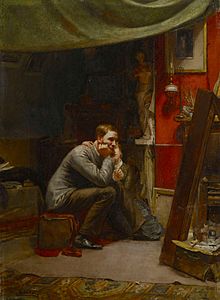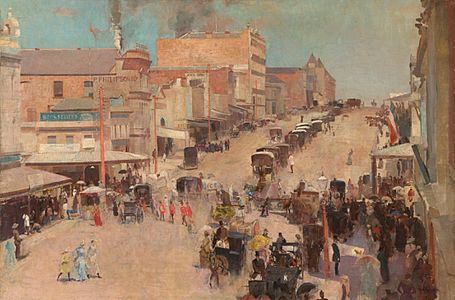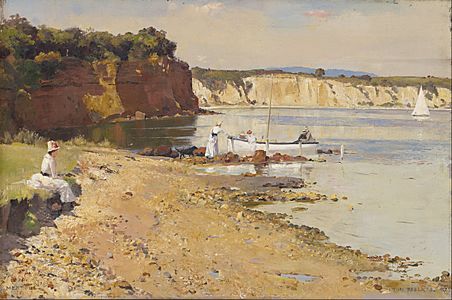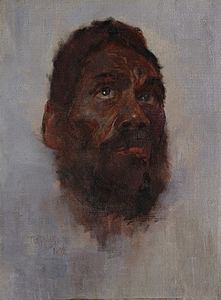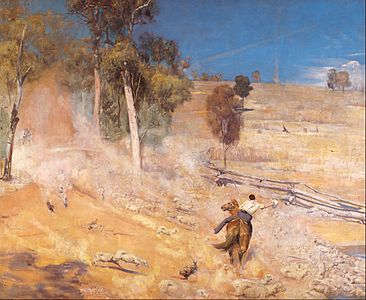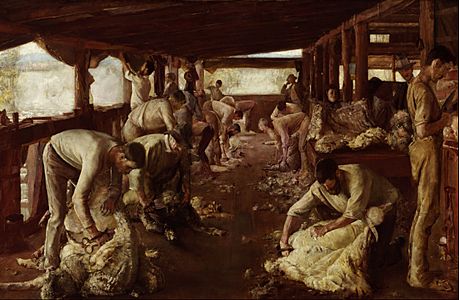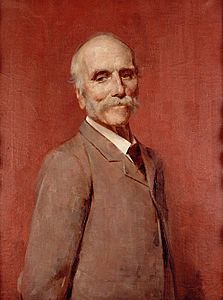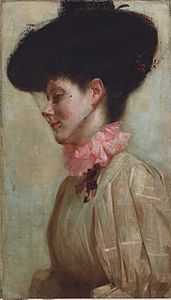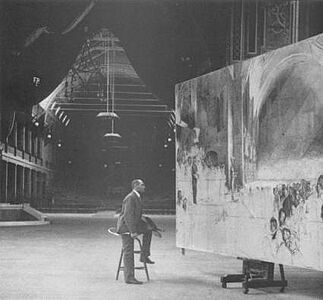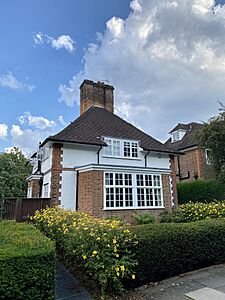Tom Roberts facts for kids
Quick facts for kids
Tom Roberts
|
|
|---|---|
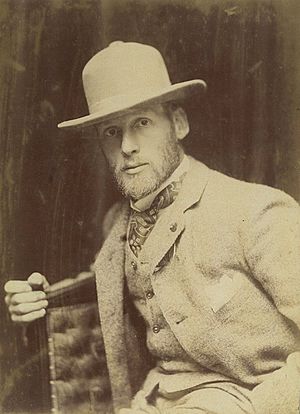
Roberts, c. 1895
|
|
| Born | 8 March 1856 Dorchester, Dorset, England
|
| Died | 14 September 1931 (aged 75) Kallista, Victoria, Australia
|
| Resting place | Illawarra churchyard, near Longford, Tasmania |
| Occupation | Artist |
| Spouse(s) |
Elizabeth (Lillie) Williamson
(m. 1896–1928)Jean Boyes
(m. 1928–1931) |
| Parent(s) | (Father) Richard Roberts (Mother) Matilda |
Thomas William Roberts (born March 8, 1856 – died September 14, 1931) was an important Australian artist. He was born in England but became a key part of the Heidelberg School art movement. This group of artists is also known as Australian Impressionists.
After studying art in Melbourne, he traveled to Europe in 1881 to learn more. He came back to Australia in 1885, full of new art ideas. He was a big supporter of painting en plein air, which means painting outdoors. He helped start the Box Hill artists' camp with Frederick McCubbin. This was the first of many outdoor painting camps used by the Heidelberg School artists.
Roberts also encouraged other artists to paint scenes of Australian life. He is famous for his "national narratives" like Shearing the Rams (1890) and A break away! (1891). He also painted Bailed Up (1895). Even though he painted these big scenes, he made his living as a portrait artist. In 1903, he finished The Big Picture. This painting shows the very first Australian Parliament meeting.
Contents
Early Life and Art Training
Roberts was born in Dorchester, England. His birth certificate says he was born on March 8, 1856. However, his tombstone has March 9 as his birthdate.
In 1869, Roberts and his family moved to Australia. They went to live with relatives in Collingwood, a suburb of Melbourne, Victoria. During the 1870s, he worked as a photographer's helper. At night, he studied art with Louis Buvelot. He also became friends with other artists who would become famous, like Frederick McCubbin.
Roberts decided to study art more and went back to England. He studied full-time at the Royal Academy Schools from 1881 to 1884. In 1883, he traveled in Spain with Australian artist John Russell. There, he met Spanish artists Laureano Barrau and Ramon Casas. They taught him about Impressionism and painting outdoors. While in London and Paris, he was influenced by painters like Jules Bastien-Lepage and James Abbott McNeill Whistler.
Painting Australian Life
From 1884 through the 1890s, Roberts worked in Victoria again. He had a studio at the well-known Grosvenor Chambers in Melbourne. In 1885, he started painting trips to areas that are now outer suburbs. He set up art camps in Box Hill and Heidelberg.
At these camps, he painted with McCubbin, Arthur Streeton, and Charles Conder. They worked on capturing Australia's unique light, heat, open spaces, and distance. Many of his most famous paintings come from this time.
In 1888, Roberts met Conder in Sydney. They painted together at Coogee beach. Conder was younger and found these painting trips very inspiring. He later followed Roberts to Melbourne to join him and Streeton at their Heidelberg art camp. Conder painted Coogee Bay focusing on shapes and colors. Roberts' Holiday sketch at Coogee (1888) showed his main interest in how nature looked. It was an early example of his outdoor "impressionist" style. This style captured the sun's bright glare on the blue sea, white sand, dry grass, and thin seaside plants.
Later Life and Important Works
In 1896, Roberts married Elizabeth (Lillie) Williamson, who was 36. They had a son named Caleb. Lillie Roberts was skilled at making picture frames. From 1903 to 1914, Roberts painted less. During this time, much of the family's money came from Lillie's work.
Roberts spent World War I in England, helping at a hospital. When he returned to Australia, he built a house in Kallista, near Melbourne. Elizabeth passed away in January 1928. Roberts then married Jean Boyes in August 1928. He died in 1931 from cancer in Kallista. His ashes are buried in the churchyard at Illawarra, near Longford, Tasmania.
Roberts painted many beautiful oil landscapes and portraits. Some of these were painted at art camps with his friend McCubbin. Two of his most famous large paintings were Shearing the Rams and The Big Picture.
Shearing the Rams
Shearing the Rams is now shown in the National Gallery of Victoria. This painting was inspired by a visit to a sheep station in Brocklesby. It shows the wool industry, which was Australia's first major export. This industry was a big part of country life.
When the painting was first shown, many people wanted it to be bought for a public art gallery. Some art critics did not think it was "high art." However, because the wool industry was so important to Australia, many people could connect with the painting. In this work, Roberts used his art training to show "the strong workers of the shearing shed."
The Big Picture
The Big Picture is displayed in Parliament House, Canberra. Roberts was paid a lot of money to paint it. It shows the first meeting of the Parliament of Australia in the Melbourne Exhibition Building. It was a huge painting, important for both the event it showed and Roberts' skill.
Roberts also made many other paintings of country people working. These include The Golden Fleece (1894), which also shows shearing sheds. A break away! shows a drover chasing sheep that have run away. Wood splitters (1886) shows men chopping trees.
Many of Roberts' paintings were small landscapes or ideas painted quickly. He showed these at the famous 9 by 5 Impression Exhibition in Melbourne. The "9 by 5" referred to the size in inches of the cigar box lids he painted on. Roberts had more paintings in this exhibition than any other artist.
Legacy and Exhibitions
Roberts' life was made into a TV mini-series in Australia in 1985 called One Summer Again.
A painting called Rejected was thought to be lost. It was shown on a BBC show in 2017. Experts decided it was a real Roberts painting from when he was a student in London. Roberts' granddaughter thought it was a self-portrait. If true, it would be his oldest self-portrait that we still have.
Roberts' art has been shown in many special exhibitions. A large show of his work traveled around Australia in 1996–97. Another was at the National Gallery of Australia from December 2015 to March 2016. Roberts was one of four Australian artists featured in the Australia’s Impressionists exhibition in London. This show ran from December 2016 to March 2017 and was the first of its kind in the UK.
Images for kids
- Tom Roberts's works
-
Mosman's Bay, 1894, New England Regional Art Museum
See also
 In Spanish: Tom Roberts para niños
In Spanish: Tom Roberts para niños
- Australian art


